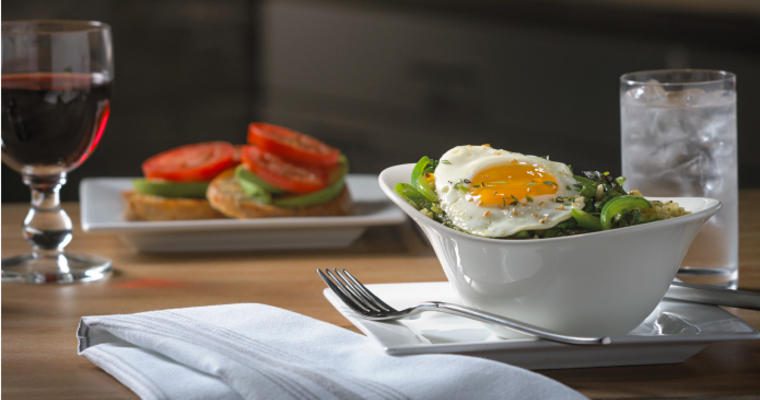The operational perspective
As restaurant operators continue to explore ways to maximize revenue, blurring the lines between breakfast, lunch and dinner is an increasingly popular strategy. It’s called all-day dining.
For many operators, this means adding breakfast to lunch and dinner offerings. It’s logical: breakfast is the fastest growing daypart, according to NPD Group. The typical consumer uses a restaurant for breakfast five more times annually than 10 years ago. Americans are clearly hungry for a.m. meals, so serving breakfast can expand your customer reach.
But today’s all-day dining trend isn’t about creating a new menu of traditional breakfast-only items. It’s about cross-utilizing lunch and dinner ingredients to create a relatively small selection of distinctive breakfast-appropriate dishes and including them on a single menu that spans all dayparts–keeping the menu compact.
As a rule of thumb, core menu sizes range from 25-40 items that best represent an operator’s brand. So you may be able to enter the all-day dining arena by incorporating just five or six new breakfast items.
One benefit of an all-day menu is that it supports higher price points for breakfast items. Using unique, high-quality ingredients allows operators to achieve higher-than normal morning check averages. For example, if a traditional breakfast menu in your area offers items ranging from $6 to $8, an all-day menu should feature $9 to $12 items. The selling price is below lunch and dinner items, but incremental guest counts make up the difference.
Add it up, and all-day menus enable operators to reach more guests, create a unique market space and keep labor costs manageable, with no significant reduction in check average.
Of course, no operational change should be considered without looking at labor. Expanding hours may require additional staffing, but the limited size of the breakfast offering, cross-utilization of ingredients and maintenance of a healthy check average may offset labor costs.
The Culinary Perspective
Innovation is a hallmark of breakfasts being added to all-day menus. Operators are incorporating higher-quality ingredients, many of them cross-utilized from lunch and dinner, and applying a new level of passion to each dish and elevating the concept of the morning meal.
Remember, innovative doesn’t have to mean complex. The goal is to create recipes that support your brand and provide a competitive advantage, not to reinvent the culinary wheel. If you serve a club sandwich at lunch, creating a breakfast item can be as simple as topping the sandwich with a fried egg. That doesn’t require a great expansion of inventory or cooking skills.
The latest Gordon Food Service Annual Research Tour revealed examples of innovative breakfast thinking, as we visited restaurants in New York, Los Angeles and Chicago. Chefs are using nontraditional breakfast ingredients from elsewhere on their menus to delight guests.
City Mouse in Chicago offers a plate of Sweet Cornmeal Griddle Cakes topped with “runny eggs,” hollandaise and a tomato-braised pork ragù borrowed from a dinner dish. Breakfast items at Chicago’s Portsmith restaurant includes a Loaded Sweet Potato Benedict—the traditional dinner side serves as a “house” for poached eggs, black beans, avocado, sour cream and salsa verde.
Rice & Gold restaurant in New York City proves all-day dining can be adapted to global cuisines. Dedicated to “modern Asian-American fare,” the restaurant incorporates Pork & Shrimp Shumai—a traditional Chinese dumpling—into an egg-based breakfast dish.
Breakfast sandwiches, popular on quick-service menus, are being reinterpreted to deliver more flavor and upscale appeal. The Eggie Sandwich at New York City’s Lalito restaurant is topped with thick strips of fried salami, grilled halloumi (a Mediterranean cheese), plantain mash and pickled onion.
Jane Q restaurant in Los Angeles serves a Southern-inflected B.E.L.T. Sandwich featuring a fried egg with candied bacon, a thick slice of housemade pickled green tomato and pimiento cheese on an egg bun. Diners can add a sunny-side-up egg to the sandwich.
These examples demonstrate that cross-utilizing ingredients from lunch and dinner can lead to a great range and variety of breakfast dishes.
Getting started
If you are considering an all-day menu, it pays to do some analysis. Review your competitive market to see what full-service operators are doing. You’ll want to check traditional breakfast operators as well. Key questions:
- Do all-day menus already exist in your market?
- What full-service and traditional breakfast operators will you compete with?
- How will your offering create differentiation for your business?
The next step is an internal analysis to determine the cost of an all-day format. In the previous section we outlined ways to minimize food and labor costs, but any change to your business is going to require some upfront investment. Document current menu performance and what you’ll need to change on the physical menu. Also consider training and marketing. This will help you budget time and dollars.
Test new breakfast items in your existing format as limited-time offers or specials. This will validate guest reception to your culinary innovation and price points.
The all-day menu monitor
Your all-day menu should offer a selection of items that:
- Are unique and distinguishable from the competition
- Can be perfectly executed every time to meet customers’ expectations
- Reduce overall inventory and increase inventory turns due to a more manageable menu size and better ingredient cross-utilization
- Reduce your labor costs by diminishing prep time, time spent switching between dayparts and decreasing the number of items to execute
- Increase execution speed—a reduced menu will free up time to focus on perfecting what remains and lead to fewer errors and send-backs
Expert insight
Contact your Sales Representative to connect with a team of business and culinary experts in your area who can help you think through an all-day menu strategy.




























